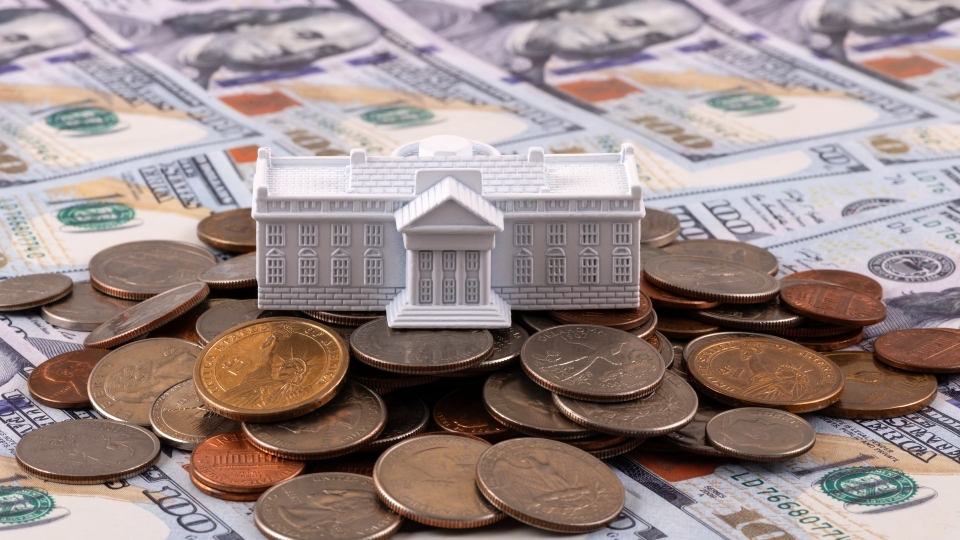New Administration Clouds Economic Outlook For New Year
January 15, 2025
- Author
- Jay Pfeifer

The economic outlook for the new year begins and ends in the White House. President-elect Trump has threatened a tariff war and promised tax breaks and fewer regulations on business. But how the global economy responds to Trump 2.0 is unclear.
Three experts offered their insights on the upcoming year.

Eric Freedman is chief investment officer for U.S. Bank Asset Management. He keeps a high-level view on capital markets around the world while overseeing more than $489 billion in assets.
Explore Insights from Eric's Team

Courtenay Brown co-authors Axios Macro, a midday newsletter that covers the pressing issues facing the global economy.
Sign Up for Courtenay's Newsletter

Siobhan O’Keefe is an assistant professor of economics at Davidson College whose work focuses on the effects of government policies on children and families.
Massive changes are underway across global politics, technology and information – how the world is aligned, how we work, how we consume news. The incoming Trump administration sounds like they want to accelerate change – a leaner government with a more pro-business orientation. If they succeed, what is the net effect across the economy?
Freedman: Immigration will be an early test for the new administration. Hiring additional border security, implementing deportations, and the costs and legal challenges associated with tougher policies are all unclear. For an administration seeking to cut costs and lower deficits, the initial policy costs could run counter to their stated objectives. Further, economists are mixed about the impact lower immigration may have on the labor market. There is pronounced risk that their policy will drive up wage costs for industries like construction and hospitality. That can lead to inflationary pressures, and inflationary pressures mean interest rates may remain elevated, acting like a tax on consumers.
Tax policy will be contentious within Congress and the Republican party itself. In addition to Congressional debate, financial markets have shown in countries including France, Germany and the U.K. that budgetary disputes have led to strong political and financial market reactions, so those recent examples loom large in investors’ minds.
Deregulation will come into focus as the administration’s priorities sharpen, but reducing the deficit can fall in that category. The newly formed Department of Government Efficiency (DOGE) initially set its sights on $2 trillion in budget savings but they have cut that projection in half less than two months later.
The Republicans’ legislative strategy (i.e. passing one large bill or multiple smaller bills) will shape some of our thinking around priorities beyond the major categories we have outlined above.
Brown: The business backdrop is expected to shift massively under Trump. Since the election, CEO optimism has soared, as Axios recently reported — a good indicator of intentions to hire and invest. In conversations I have, it's clear business leaders are concerned about trade policy and the possibility of a global trade war. But excitement about tax cuts appears to outweigh those worries, at least so far.
It's also important to remember the Biden-era investment boom that came as a byproduct of incentives in the CHIPS Act and other legislation. Spending on factory construction has skyrocketed. Tech companies have poured large sums into AI-related investment, including for the data centers necessary to power the technology. This type of activity has buoyed the economy.
Of course, whether Biden-era legislation survives under Trump is an open question.
O’Keefe: I think we’re more likely to end up stuck in the middle, where the tax cuts from the first Trump term are made permanent, without any meaningful decreases in spending to accompany them. History doesn’t always repeat itself, and I would be happy to be proven wrong here, but politicians love to cut taxes. While they sometimes talk a big game about cutting spending, they are less willing to make real changes to the biggest parts of the U.S. federal budget: Social Security, Medicare and defense spending. In the short run, continuing to run large deficits doesn’t seem to be hurting the U.S. economy. But when we run into the next big crisis (whether it’s a pandemic, a recession or something worse), we may wish we’d saved some fiscal capacity for a rainy day.
How will President Trump’s protectionist policies weigh on the economy in 2025? Will increased tariffs pass along higher prices to the consumer? What other friction or opportunities might Trump’s promised tariffs bring?
Freedman: Trade and tariffs appear to be a negotiating tool for the incoming administration as well as a tool for funding economic agenda items, including tax cuts. Financial markets will be closely watching the interplay between expected tax cuts and tariff efficacy, including how countries respond to the threat of tariffs and whether companies pass tariff costs on to consumers.
While we view the American consumer as a whole in relatively good shape, lower-income consumers who are facing elevated shelter, transportation and food costs are unlikely to tolerate higher prices on a sustained basis. That intolerance can spread to other income cohorts and ultimately impact corporate earnings and stock prices.
Brown: Trump 2.0 promises to slap tariffs on all imports — including those from U.S. allies. Trump hopes to nurture domestic industry, though that outcome is far from guaranteed.
Mainstream economists agree tariffs are economically harmful. In theory, companies will pass some or all of the tariff costs to consumers. We reported on a memo from the nonpartisan Congressional Budget Office that modeled the effect of what Trump says his trade policy might look like: a 60% tariff on Chinese goods alongside a tariff of 10% on all other inbound products. Assuming nations retaliate with tariffs on U.S.-made goods, the agency found what one might expect: higher prices initially and weaker economic growth — though deficits would shrink from the tariff revenue.
But no one knows what trade policy will actually look like under Trump. There are legal questions about how quickly tariffs can ultimately take effect.
There's another unknown: How trade policy impacts the economy depends on what else is happening with the economy at the time.
O’Keefe: In the short term, I expect tariffs to make things harder for most consumers. A tariff is a tax on imported goods, and unless the firm selling the imported goods absorbs the entire amount of the tax increase (unlikely), this means prices will go up for consumers. A lot of the goods we buy are imported, and even goods that are manufactured in the U.S. usually contain imported components, so this will be felt widely across the economy. Additionally, countries often respond to tariffs by placing their own retaliatory tariffs on U.S. goods. This compounds the negative effects of tariffs because this reduces international demand for goods produced in the United States.
In the long run, this could potentially make it easier for Americans to start businesses in the markets where tariffs are dampening foreign competition. Historically, things haven’t played out this way — for example, research shows that tariffs during the late 1800s/early 1900s did not increase productivity or growth. And if potential entrepreneurs think these tariffs are temporary, they may not want to take the risk of starting a new business.
The stakes of the U.S.-China relationship have never been higher. These are definitively the two global economic powers with extraordinary control over supply chains and technology. What is the ripple effect of that elevated tension?
Freedman: The incoming administration views tariffs as both a negotiating tool and a funding mechanism. China has resources that the U.S. requires, and vice versa. China has allies and enemies, as does the United States. How global players react to the initial tariff salvos will be critical, and in some cases, the reaction functions may evolve over time. As investors, sometimes you make decisions in advance of an event, and in other cases, you wait to see how things develop. Our approach has been to wait for the initial reaction functions before determining how we may want to alter our positioning.
Brown: This year will mark five years since the pandemic lockdown. The fallout from that shock left a permanent scar on geopolitics and the global economy. Tensions between the U.S. and China of course predate the pandemic, but there have since been significant efforts to rely less on China for key supply chain inputs in the name of national security.
Tough China policy is the throughline between Biden and Trump. But China's economy is not the powerhouse it used to be: it faces deflationary conditions and lackluster demand and its leaders are taking huge steps to stimulate the economy. China might be in a weaker position relative to Trump 1.0 to sustain trade blows.
O’Keefe: In some ways, I think we’re seeing a continuation of the reorganization of supply chains started during the pandemic. 2020 showed a lot of businesses that if you can only source a vital input from one place (especially if that place is across an ocean and there’s a risk of conflict) that means your firm is in a precarious position. However, resilience often comes with a cost. Just like consumers, firms don’t like to pay higher prices either. But additional tensions with China may make that higher cost seem worth the reduction in uncertainty.
Inflation has been top-of-mind since 2021. With the Fed cutting interest rates three times this fall, is it time to declare victory in the war on inflation?
Freedman: We would not unfurl the “mission-accomplished” banner quite yet. Inflationary pressures have been sticky, and in December, the Federal Reserve offered more cautious guidance about future rate cuts due to their view that “almost all participants judged that upside risks to the inflation outlook had increased. As reasons for this judgment, participants cited recent stronger-than-expected readings on inflation and the likely effects of potential changes in trade and immigration policy.
While we have to anticipate some inflationary policies emerging from the incoming administration, we do see several variables that may restrain inflation or potentially counteract a sharp advance. First, inflation can have some seasonality and statistical quirks attached to it that may reverse in the first quarter. Second, shelter costs, which make up 40% of the Consumer Price Index, appear to be moderating. Third, China’s economy remains subdued so we do not anticipate China exporting inflation without tariffs providing some tailwinds. How the consumer fares post-holiday season will be key.
Brown: For a stretch last year, it looked like the Fed could take an inflation victory lap. Officials cut rates because of growing confidence that inflation was approaching the Fed's 2% target. Plus the labor market looked wobbly and lower rates could help keep it chugging along.
That dynamic has since flipped. Recent data suggests the progress on cooling inflation is stalling. The labor market is slowing, though not nearly as quickly as previously feared. As of December, the median Fed official anticipated just two rate cuts this year — half as many as believed just three months earlier. Those projections are shaky given the unknown economic consequences of Trump policy.
O’Keefe: While the Fed has started to cut interest rates, I think it’s too early to declare victory on inflation. First, inflation is still stubbornly hovering around 2.5%. While this is an improvement from the peak in 2022, it is still above the Fed’s historical target of 2%. If anything, the most recent inflation numbers from the end of 2024 show prices going in the wrong direction. Especially since many of Trump’s proposed policies are potentially inflationary (tariffs, tax cuts), I don’t think we’re done with inflation yet.
What is one threat to the economy that are we not paying enough attention to?
Freedman: One item that we don’t think gets enough attention is the impact higher interest rates may have on consumer spending. While market participants tend to focus on what is ahead of us, we cannot forget that consumers have already endured significant interest rate increases from the U.S. Federal Reserve.
Since the Fed started raising interest rates in March of 2022, the domestic economy has experienced significant increases to borrowing costs with minimal relief from the Fed’s interest-rate reduction campaign that began in September, and markets are currently only anticipating one more cut for 2025. Credit card borrowing costs, mortgages and non-traditional financing sources have all increased, leaving consumers in a more challenged position. We have not seen U.S. 10-Year Treasury yields sustainably above 5% for 18 calendar years, or before the Financial Crisis. The risk that interest rates jump and remain elevated in a credit-dependent economy is worthy of more attention.
Brown: It is a challenge, rather than a threat. Major economies — Germany, France and even Canada — face unprecedented political dysfunction alongside sluggish growth. Let's just call it a less than desirable combination.
The far-right is gaining more power around the world. Nowhere is that more on display than in Europe. France's government dissolved over a budget battle. It largely came at the hands of far-right firebrand Marine Le Pen.
Germany's government collapsed after deep division on how to reinvigorate the stagnant economy. Germany will soon hold parliamentary elections. All eyes will be on any gains by the far-right Alternative for Germany party.
No one knows how Trump policy will ripple across the globe. But as it stands, major economies (except the U.S.) are already slowing. Structural factors, like ageing populations, are set to further weigh on activity. It's possible their politicians might be too dysfunctional to address it.
O’Keefe: What I worry about is potential threats to the Federal Reserve’s political independence. The Fed has a tough job — as much as people don’t like inflation, they also don’t like high interest rates. When the Fed increases their interest rates, interest rates across the economy also increase. This makes it harder for firms or families to make big purchases. And no one likes that.
Independence allows the Fed to make choices that are good for the economy in the long run but politically unpopular in the short run.
Trump and many of his advisors have been very critical of the Fed. Policy differences are reasonable and natural, but this criticism has gone beyond that — Trump has made it clear that he wants to be able to influence the Fed’s decisions in his next term. While the Fed is in many ways insulated from the political process, the president is very powerful. Additionally, Trump will get to decide whether to reappoint Jerome Powell or replace him when his term ends in 2026. Trump will also get to appoint two members of the Board of Governors during his term. So while Trump won’t be able to completely remake the Fed in his image, a move toward a more political Fed is very concerning for the long-term stability of the American economy.



